| Article ID | Journal | Published Year | Pages | File Type |
|---|---|---|---|---|
| 9760506 | Journal of Power Sources | 2005 | 11 Pages |
Abstract
A non-destructive inverse method is applied to predict the global temperature distribution at the interface between the carbon plate and the membrane electrode assembly of a proton exchange membrane fuel cell (PEMFC) based on the measured temperature data on the outer surface of the end plate. A direct problem solver is built to provide temperature solutions for various physical conditions and is then incorporated with the conjugate gradient method to develop an inverse method for temperature prediction. Three specified functions are taken as exact temperature distributions at the interfaces and are predicted by using the inverse method. The validity of the inverse approach is demonstrated by investigating the effects of the number and locations of the measurement points and the experimental uncertainty on the accuracy of the predicted solutions. In addition, the possibility of internal temperature prediction based on the temperature data on the edges of the carbon plate is also studied. Results show that the inner surface temperatures of the carbon plates in contact with the MEA is possible to be determined based on the measured temperature data on the outer surfaces.
Related Topics
Physical Sciences and Engineering
Chemistry
Electrochemistry
Authors
Chin-Hsiang Cheng, Mei-Hsia Chang,
